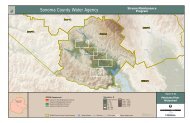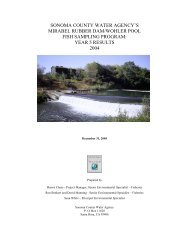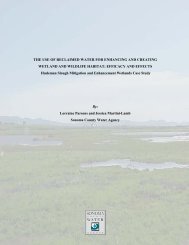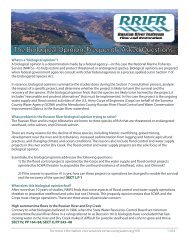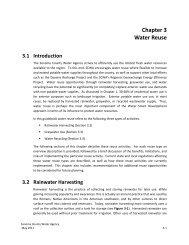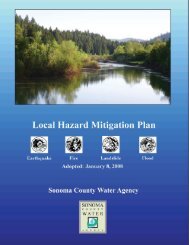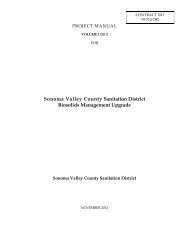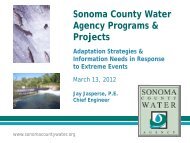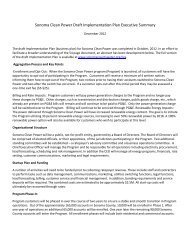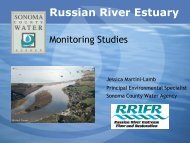Hydrography of the Russian River Estuary - Sonoma County Water ...
Hydrography of the Russian River Estuary - Sonoma County Water ...
Hydrography of the Russian River Estuary - Sonoma County Water ...
Create successful ePaper yourself
Turn your PDF publications into a flip-book with our unique Google optimized e-Paper software.
4. Discussion<br />
Circulation, stratification, and water properties were monitored in <strong>the</strong> <strong>Russian</strong> <strong>River</strong><br />
estuary during late summer and fall 2009 – a dry year in which river flow was managed<br />
at a lower level than normal. Specific attention is directed at conditions during a monthlong<br />
closure event in September-October. A dense lower layer <strong>of</strong> high-salinity water is<br />
trapped in <strong>the</strong> estuary when <strong>the</strong> mouth closes, with water column stability increasing<br />
over time as well as an expansion <strong>of</strong> stable stratification into <strong>the</strong> inner estuary, which is<br />
devoid <strong>of</strong> salt during periods <strong>of</strong> higher river flow. Within a week <strong>of</strong> strong stratification<br />
being established, <strong>the</strong> near-bottom waters become hypoxic (i.e., below <strong>the</strong> 1-percent<br />
light level). At mid-depth, however, penetration <strong>of</strong> light leads to photosyn<strong>the</strong>sis and a<br />
stable layer in which oxygen levels are super-saturated during <strong>the</strong> day. At similar<br />
depths, <strong>the</strong>rmal radiation is also trapped and water temperatures are maximum. A thin<br />
surface layer is typically well mixed and in equilibrium with <strong>the</strong> atmosphere in terms <strong>of</strong><br />
both dissolved oxygen and temperature. Stratification and deep-water hypoxia persist<br />
until tidal action returns with opening <strong>of</strong> <strong>the</strong> mouth in October.<br />
While dense waters may be trapped beneath a pycnocline even during times when <strong>the</strong><br />
mouth is open, surface waters move through <strong>the</strong> estuary quickly when <strong>the</strong> mouth is<br />
open (residence times ~ 1day). Similarly mixed waters are rapidly removed from <strong>the</strong><br />
estuary through <strong>the</strong> action <strong>of</strong> tides. However, as tidal action weakens due to a reduction<br />
in mouth conveyance, mid-depth and near-bottom saline waters become resident in a<br />
stratified estuary. Residence time typically exceeds <strong>the</strong> period in which muted tides are<br />
observed and <strong>the</strong> mouth closes with <strong>the</strong>se waters still retained in <strong>the</strong> estuary – thus<br />
residence time becomes closure time (over a month in September-October 2009). As<br />
stratification develops later in <strong>the</strong> inner estuary during closure, saline waters are only<br />
trapped <strong>the</strong>re later and residence in this location is shorter (still long enough for deoxygenation)<br />
– but <strong>the</strong>se saline waters were already resident in <strong>the</strong> estuary and have<br />
only shifted location. Meanwhile, surface waters will continue to move through and out<br />
<strong>of</strong> <strong>the</strong> estuary as long as <strong>the</strong> bed <strong>of</strong> <strong>the</strong> mouth channel (or <strong>the</strong> crest <strong>of</strong> <strong>the</strong> berm) is<br />
below <strong>the</strong> estuary water level. This “overflow” state has been observed at <strong>the</strong> mouth <strong>of</strong><br />
<strong>the</strong> <strong>Russian</strong> <strong>River</strong>, but this is not common, nor does it persist for more than a few days<br />
(PWA, 2010). Even when closed, water is lost through <strong>the</strong> sand barrier (up to a rate <strong>of</strong><br />
about 60cfs later in <strong>the</strong> September 2009 closure). These waters are primarily lost from<br />
above <strong>the</strong> pycnocline (Section 3.4.2), implying a residence time for near-surface waters<br />
<strong>of</strong> order 10 days (calculated from volume/seepage rate). While this weak throughflow<br />
entrains some water from <strong>the</strong> upper pycnocline, water beneath <strong>the</strong> pycnocline is<br />
67





